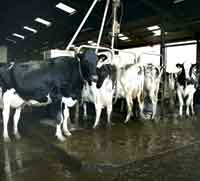Out-of-parlour-feeders boosting yields

Out-of-parlour feeders are vital to supporting a high yielding Lancashire herd at a low concentrate cost for every litre, as Jeremy Hunt found out
Out-of-parlour feeders, once at the cutting edge of cow nutrition, are now often found rusting behind the cubicle shed as TMR diets have become the norm. But a high-yielding Lancashire dairy herd being fed a complete diet ration still relies heavily on this method of providing supplementary feed to meet the dietary needs of high yielders.
Richard Walmsley farms 250 acres – including 70 acres of maize and 35 acres of whole-crop at Beechwood Farm, Cockerham, where he’s milking 380 Holstein cows with his father Derek. Recent years have seen big changes in this dairy unit close to Morecambe Bay, Lancashire.
“Three years ago the herd was running 230 cows and we were rearing our own replacements. But the slump in the milk price made us look closely at the business and we reckoned we’d have to go out of milk unless we made some changes.”
“We decided to increase the number of milk cows and sell the youngstock. We bought a complete herd to lift numbers, switched to being a flying herd and started milking three times a day,” says Richard.
The herd has now resumed rearing its own heifers but the Walmsleys remain committed to three-times-a-day milking and running almost 400 cows. The herd is housed all year round and is currently producing an average of just over 9500 litres.
Andrew Holland of Ontrak Nutrition is the farm’s consultant and formulates all the cow rations – both the TMR blend and the out-of-parlour nut formulations. Both are made to his specification and altered accordingly to balance the forages. There is no in-parlour feeding but out-of-parlour feeders have been used for the last five years.
“When I became involved with the farm there were issues with rumen health and fertility. The herd had achieved a significant improvement in yield but at a cost to cow health. There was far too much rumen protein, too much fibre and too much fat going into the cows and not enough energy coming from starch. The ration wasn’t balanced to complement the forage.
“A lot of concentrate was being fed but the diet required a higher level of starch. To redress the balance we reduced the level of total concentrate, introduced caustic wheat and added some better quality protein. This allowed the rumen to use the forage portion of the diet and begin to alleviate some of the stress the cows were under. And we had an immediate response,” says Mr Holland.
About 3kg of concentrate were taken out of the diet, which in itself not only instigated an improvement in the cows’ well-being but also cut costs for every litre of milk produced.
Yield is currently improving, calving index is now about 415 days reflecting an improvement in fertility, and foot problems have been significantly reduced.
“We were down to about 45-50% when we PD’d cows, now we’re getting back to 85-90%,” says Richard.
The current ration is based on 25kg grass silage, 8.5kg maize silage, 5kg Grainbeet, 4.5kg of blend 1.5kg caustic wheat, 1kg sugar beet pulp and 1kg molasses plus minerals.
“That’s feeding the high yielders giving 29 litres; above that we’re feeding 0.45kg a litre through the out-of-parlour feeders. The top yielding cows are getting up to 9kg in the first three weeks of lactation and are held on that until 40 days post-calving after which they are fed through the feeders according to yield,” says Mr Holland.
He believes the reputation of out-of-parlour feeders has suffered because of the quality of the feed being fed through them.
“We’re formulating a precise diet for the feeders using various ingredients. The current inclusions are sugar beet pulp, wheat, soya, soya hulls, molasses, maize distillers, palm oil and prairie meal.
“We constantly monitor what’s being fed through them and have as much control over that as we have with the TMR, with changes to the formulations being made as necessary.
“You can’t just feed a standard cake in the feeders and not know how much starch there is in it or if it’s high-fibre and expect it to complement the TMR ration.
“Using the out of parlour feeders is the best way of getting more starch in without tipping these cows over the edge and risking acidosis. And it’s the most accurate way of doing it,” says Mr Holland.
He’s adamant out-of-parlour feeders are vital to supporting high yielding herds at a low concentrate cost per litre.
“TMR diets will only work in large herds when you can calve big blocks of cows in short periods and put them on a TMR diet to feed for say 40 litres. In terms of feed efficiency I don’t think total dependence on TMR works for today’s high yielders.”
